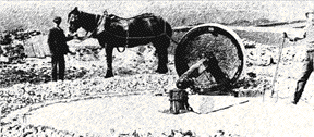Millstone images - edge runners Home Millstone page
 |
An edge runner used to crush lead ore at the Odin mine, Castleton. This is a unique example where both the steel track, the runner and it's steel tyre are still in place. Ore would have been shoveled onto the track so that the crushed material could later be separated by the "washing" process.
|
 |
Edge runner at a lead mine on Eldon Hill
|
 |
An edge runner in use: the horse pulled one end of a massive spindle, fixed at the other end to a pivot in the centre of the circle. The runner then rolled along the track. Large pieces of lead ore were shovelled in front of the runner. As the ore was crushed, minerals tended to break at their bondaries. The crushed ore could then be "washed" - sorted by density in a water current so that the lead ore could be finally separated and smelted. This arrangement is sometimes called a "Chilean Mill".
|
 |
Edge runner, Cheddleton Mill, near Leek. This one was used to crush minerals used for dyes and paint - the central shaft was turned by the water mill and minerals placed on the bed. Other designs used the same principle to crush materials as varied as glass prior to recycling (cullet), bark for tanning, cork for linoleum and apples for cider.
|
Copyright @ 2006 Stephen N.Wood. All rights reserved.